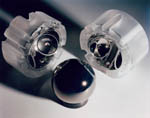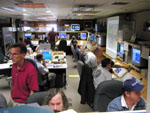WEEKLY HIGHLIGHTS FOR 31 JULY 2004:
GRAVITY PROBE B MISSION UPDATE


Gravity Probe B successfully accomplished a major milestone this week as the final two gyroscopes were spun up to high spin speed. All four gyros are now spinning at high spin speed. The spacecraft is in excellent health, and all subsystems are continuing to perform well. With this major accomplishment behind us the Program is entering the home stretch of the Initialization and Orbit Checkout (IOC) phase of the mission.
This week's high speed spin-up operations were performed on gyro #3 (Tuesday) and gyro #1 (Friday). There were no anomalies during the spin up. The SQUID readout FFT tracked the spin up in real-time. As expected, the other gyros spun down approximately 15% with each high speed spin-up operation due to pressurization of the Probe caused by gas leakage during the spin-up. Final spin speeds of the gyros are now gyro #1 (80.0 Hz - 4800 rpm), gyro #2 (62.3 Hz - 3738 rpm), gyro #3 (82.7 Hz - 4962 rpm) and gyro #4 (65.5 Hz - 3930 rpm). At these spin speeds, GP-B's relativity measurement is expected to be significantly better than specification. Therefore, no further gyro high speed spin-up operations are planned.
Fine-tuning of the Attitude and Translation Control system (ATC) is nearly complete, and the ATC is performing well. This past week, we continued fine-tuning the drag-free software used by the ATC to optimize its performance at the current spacecraft roll rate of 0.52 rpm. Tests from parameter changes we made to the ATC system indicate that we have reduced the time it takes to re-lock onto the guide star from as much as 15 minutes to less than a minute. We have also increased the number of reference stars seen by the star tracker from 3 to 8.
Next week we will be performing a few final operations prior to beginning taking science data. The most significant operation left to be performed is the spin axis alignment of each gyro. This is performed using the Gyro Suspension System in a special oscillation mode to slowly align each gyro spin axis to be in nearly perfect alignment with the Guidestar. Having the gyros aligned at the beginning of the mission makes any precession caused by general relativity simpler to measure. We are nearly complete aligning the spin axis of gyros #2 and #4 and plan to align #3 and #1 next week. Another operation for next week is to perform a final bake-out operation to remove any residual helium molecules from around the gyros. This operation is performed by heating up the instrument area slightly (to approximately 6 degrees Kelvin) , which will cause residual helium to migrate to a collector device in the Probe. And finally, the final operation prior to science is to command the spacecraft to begin drag-free operations.
The spacecraft is being controlled from the Gravity Probe B Mission Operations Center, located here at Stanford University. The
Stanford-NASA/MSFC-Lockheed Martin operations team is continuing to perform superbly.


Images & Photos: The diagram of the gyro rotor and housings is also from the GP-B Image Archive. The first photo, showing the GP-B gyroscope rotor (sphere) and housings, was taken by photographer Don Harlan. In the next two photos, taken by GP-B Public Affairs Coordinator, Bob Kahn, team members in the GP-B Mission Operations Center here at Stanford are spinning up gyro #4 to full speed. Click on the thumbnails to view enlarged copies of these images.
More links on recent topics
- Track the satellite in the sky
- Photo, video & and news links
- Build a paper model of the GP-B Spacecraft
- Following the mission online
- Our mailing list - receive the weekly highlights via email
- The GP-B Launch Companion in Adobe Acrobat PDF format. Please note: this file is 1.6 MB, so it may take awhile to download if you have a slow Internet connection.
Previous Highlight
Index of Highlights
